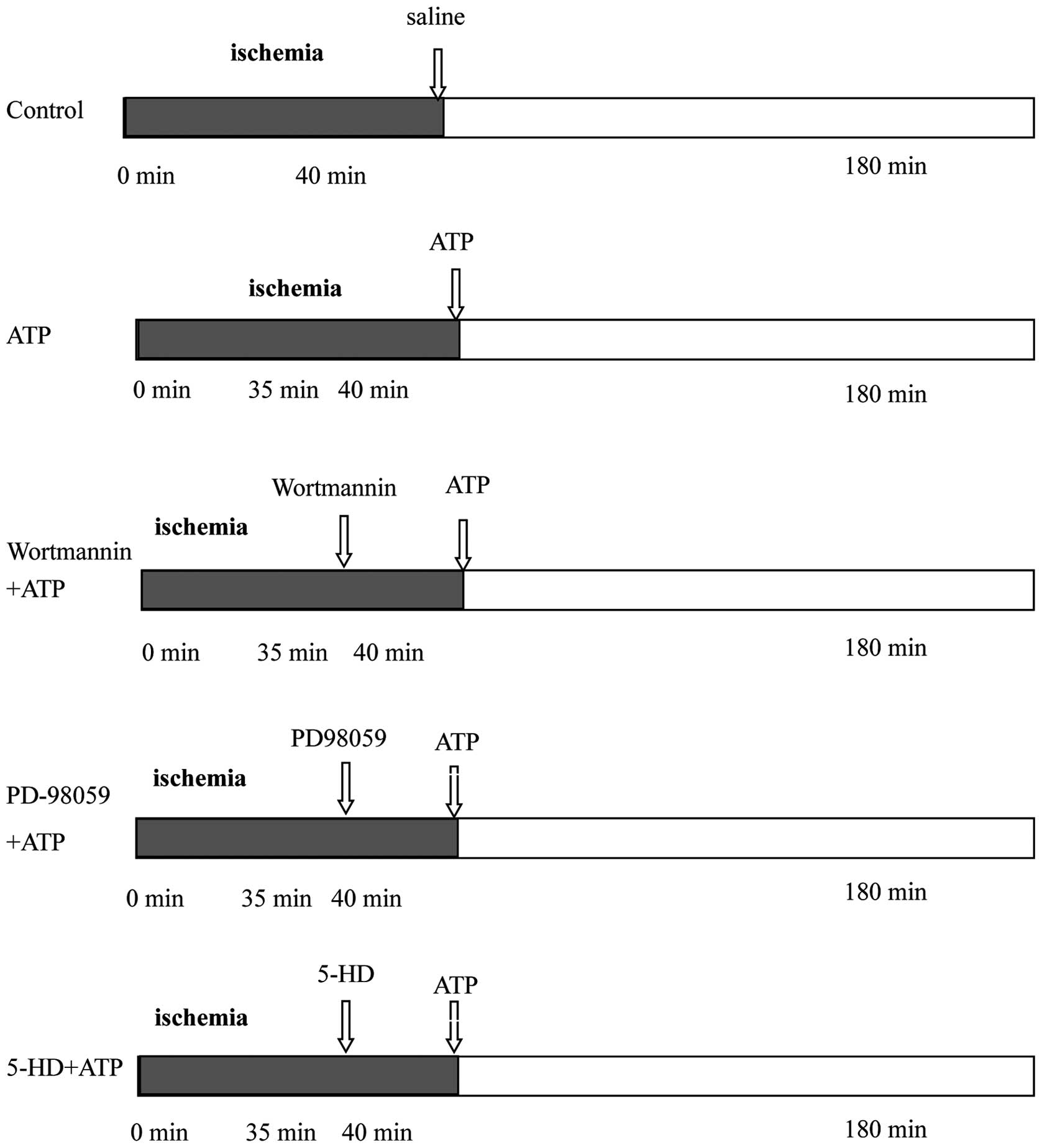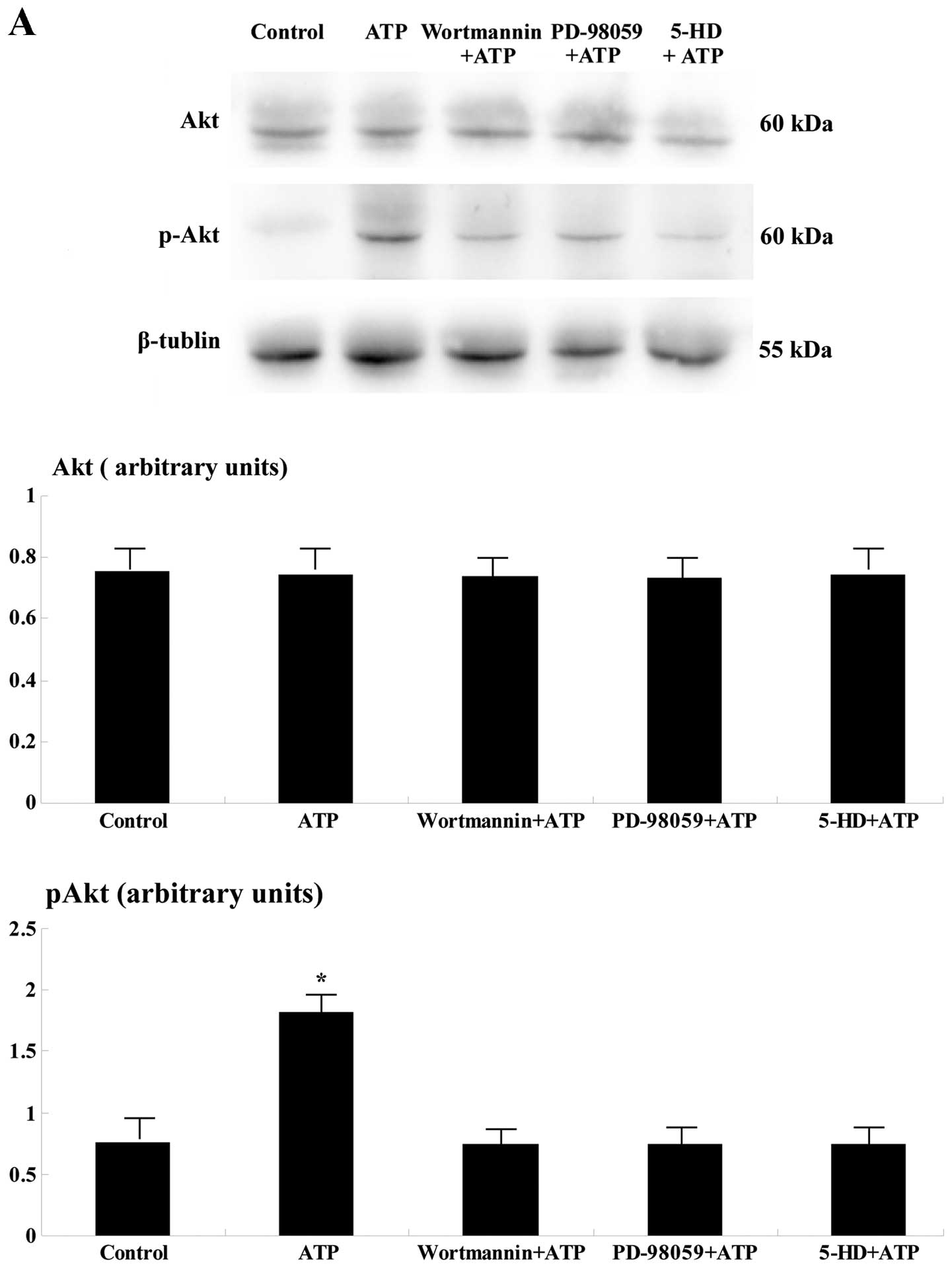|
1
|
Yellon DM and Baxter GF: Protecting the
ischaemic and reperfused myocardium in acute myocardial infarction:
distant dream or near reality? Heart. 83:381–387. 2000. View Article : Google Scholar : PubMed/NCBI
|
|
2
|
Hearse DJ and Bolli R: Reperfusion induced
injury: manifestations, mechanisms, and clinical relevance.
Cardiovasc Res. 26:101–108. 1992. View Article : Google Scholar : PubMed/NCBI
|
|
3
|
Yellon DM and Baxter GF: Reperfusion
injury revisited: is there a role for growth factor signaling in
limiting lethal reperfusion injury? Trends Cardiovasc Med.
9:245–249. 1999. View Article : Google Scholar : PubMed/NCBI
|
|
4
|
Kuno A, Solenkova NV, Solodushko V, Dost
T, Liu Y, Yang XM, Cohen MV and Downey JM: Infarct limitation by a
protein kinase G activator at reperfusion in rabbit hearts is
dependent on sensitizing the heart to A2b agonists by protein
kinase C. Am J Physiol Heart Circ Physiol. 295:H1288–H1295. 2008.
View Article : Google Scholar : PubMed/NCBI
|
|
5
|
Urmaliya VB, Pouton CW, Ledent C, Short JL
and White PJ: Cooperative cardioprotection through adenosine A1 and
A2A receptor agonism in ischemia-reperfused isolated mouse heart. J
Cardiovasc Pharmacol. 56:379–388. 2010. View Article : Google Scholar : PubMed/NCBI
|
|
6
|
Kin H, Zatta AJ, Lofye MT, Amerson BS,
Halkos ME, Kerendi F, Zhao ZQ, Guyton RA, Headrick JP and
Vinten-Johansen J: Postconditioning reduces infarct size via
adenosine receptor activation by endogenous adenosine. Cardiovasc
Res. 67:124–133. 2005. View Article : Google Scholar : PubMed/NCBI
|
|
7
|
Regan SE, Broad M, Byford AM, Lankford AR,
Cerniway RJ, Mayo MW and Matherne GP: A1 adenosine receptor
overexpression attenuates ischemia-reperfusion-induced apoptosis
and caspase 3 activity. Am J Physiol Heart Circ Physiol.
284:H859–H866. 2003. View Article : Google Scholar : PubMed/NCBI
|
|
8
|
Philipp S, Yang XM, Cui L, Davis AM,
Downey JM and Cohen MV: Postconditioning protects rabbit hearts
through a protein kinase C-adenosine A2b receptor cascade.
Cardiovasc Res. 70:308–314. 2006. View Article : Google Scholar : PubMed/NCBI
|
|
9
|
Erga KS, Seubert CN, Liang HX, Wu L,
Shryock JC and Belardinelli L: Role of A(2A)-adenosine receptor
activation for ATP-mediated coronary vasodilation in guinea-pig
isolated heart. Br J Pharmacol. 130:1065–1075. 2000. View Article : Google Scholar : PubMed/NCBI
|
|
10
|
Lian ZX, Liu F, Liu S, Xin H, Chen ZY,
Tian JH, An Y and Cai SL: Cardioprotection of ischemic
postconditioning and ATP-postconditioning in rabbits is associated
with the activation of adenosine receptors. Eur Heart J. 27:(Suppl
1). 722006.
|
|
11
|
Hausenloy DJ, Tsang A and Yellon DM: The
reperfusion injury salvage kinase pathway: a common target for both
ischemic preconditioning and postconditioning. Trends Cardiovasc
Med. 15:69–75. 2005. View Article : Google Scholar : PubMed/NCBI
|
|
12
|
Bopassa J-C, Ferrera R, Gateau-Roesch O,
Couture-Lepetit E and Ovize M: PI 3-kinase regulates the
mitochondrial transition pore in controlled reperfusion and
postconditioning. Cardiovasc Res. 69:178–185. 2006. View Article : Google Scholar : PubMed/NCBI
|
|
13
|
Kin H, Wang NP, Mykytenko J, Reeves J,
Deneve J, Jiang R, Zatta AJ, Guyton RA, Vinten-Johansen J and Zhao
ZQ: Inhibition of myocardial apoptosis by postconditioning is
associated with attenuation of oxidative stress-mediated nuclear
factor-kappa B translocation and TNF alpha release. Shock.
29:761–768. 2008.PubMed/NCBI
|
|
14
|
Fleetwood G, Coade SB, Gordon JL and
Pearson JD: Kinetics of adenine nucleotide catabolism in coronary
circulation of rats. Am J Physiol. 256:H1565–H1572. 1989.PubMed/NCBI
|
|
15
|
Nanto S, Kitakaze M, Takano Y, Hori M and
Nagata S: Intracoronary administration of adenosine triphosphate
increases myocardial adenosine levels and coronary blood flow in
man. Jpn Circ J. 61:836–842. 1997. View Article : Google Scholar : PubMed/NCBI
|
|
16
|
Olivetti G, Quaini F, Sala R, Lagrasta C,
Corradi D, Bonacina E, Gambert SR, Cigola E and Anversa P: Acute
myocardial infarction in humans is associated with activation of
programmed myocyte cell death in the surviving portion of the
heart. J Mol Cell Cardiol. 28:2005–2016. 1996. View Article : Google Scholar : PubMed/NCBI
|
|
17
|
Vilahur G, Cubedo J, Casani L, Padro T,
Sabate-Tenas M, Badimon JJ and Badimon L: Reperfusion-triggered
stress protein response in the myocardium is blocked by
post-conditioning. Systems biology pathway analysis highlights the
key role of the canonical aryl-hydrocarbon receptor pathway. Eur
Heart J. 34:2082–2093. 2013. View Article : Google Scholar : PubMed/NCBI
|
|
18
|
Heusch G, Boengler K and Schulz R:
Cardioprotection: nitric oxide, protein kinases, and mitochondria.
Circulation. 118:1915–1919. 2008. View Article : Google Scholar : PubMed/NCBI
|
|
19
|
Goodman MD, Koch SE, Fuller-Bicer GA and
Butler KL: Regulating RISK: a role for JAK-STAT signaling in
postconditioning? Am J Physiol Heart Circ Physiol. 295:H1649–H1656.
2008. View Article : Google Scholar : PubMed/NCBI
|
|
20
|
Zhu M, Feng J, Lucchinetti E, Fischer G,
Xu L, Pedrazzini T, Schaub MC and Zaugg M: Ischemic
postconditioning protects remodeled myocardium via the PI3K-PKB/Akt
reperfusion injury salvage kinase pathway. Cardiovasc Res.
72:152–162. 2006. View Article : Google Scholar : PubMed/NCBI
|
|
21
|
Yang XM, Krieg T, Cui L, Downey JM and
Cohen MV: NECA and bradykinin at reperfusion reduce infarction in
rabbit hearts by signaling through PI3K, ERK, and NO. J Mol Cell
Cardiol. 36:411–421. 2004. View Article : Google Scholar : PubMed/NCBI
|
|
22
|
Cohen MV, Yang XM, Liu Y, Solenkova NV and
Downey JM: Cardioprotective PKG-independent NO signaling at
reperfusion. Am J Physiol Heart Circ Physiol. 299:H2028–H2036.
2010. View Article : Google Scholar : PubMed/NCBI
|
|
23
|
Hide EJ and Thiemermann C: Limitation of
myocardial infarct size in the rabbit by ischaemic preconditioning
is abolished by sodium 5-hydroxydecanoate. Cardiovasc Res.
31:941–946. 1996. View Article : Google Scholar : PubMed/NCBI
|
|
24
|
Yang XM, Proctor JB, Cui L, Krieg T,
Downey JM and Cohen MV: Multiple, brief coronary occlusions during
early reperfusion protect rabbit hearts by targeting cell signaling
pathways. J Am Coll Cardiol. 44:1103–1110. 2004. View Article : Google Scholar : PubMed/NCBI
|
|
25
|
Han J, Kim N, Joo H, Kim E and Earm YE:
ATP-sensitive K(+) channel activation by nitric oxide and protein
kinase G in rabbit ventricular myocytes. Am J Physiol Heart Circ
Physiol. 283:H1545–H1554. 2002. View Article : Google Scholar : PubMed/NCBI
|
|
26
|
Burnstock G: Overview: purinergic
receptorsRole of adenosine and adenosine nucleotides in the
biological system. Imai S and Nakazawa M: Elsevier Science;
Amsterdam: pp. 1–6. 1991
|
|
27
|
Komamura K, Ito H, Takiuchi S, Iwakura K,
Maruyama A, Masuyama T, Minamino T, Node K, Kitakaze M and Hori M:
Transient intracoronary infusion of ATP after reperfusion reduces
the extent of no-reflow and infarct size in dogs. J Am Coll
Cardiol. 25:227A–228A. 1995. View Article : Google Scholar
|
|
28
|
Mahaffey KW, Puma JA, Barbagelata NA,
DiCarli MF, Leesar MA, Browne KF, Eisenberg PR, Bolli R, Casas AC,
Molina-Viamonte V, et al: Adenosine as an adjunct to thrombolytic
therapy for acute myocardial infarction: results of a multicenter,
randomized, placebo-controlled trial: the Acute Myocardial
Infarction STudy of ADenosine (AMISTAD) trial. J Am Coll Cardiol.
34:1711–1720. 1999. View Article : Google Scholar : PubMed/NCBI
|
|
29
|
Ross AM, Gibbons RJ, Stone GW, Kloner RA
and Alexander RW: AMISTAD-II Investigators: A randomized,
double-blinded, placebo-controlled multicenter trial of adenosine
as an adjunct to reperfusion in the treatment of acute myocardial
infarction (AMISTAD-II). J Am Coll Cardiol. 45:1775–1780. 2005.
View Article : Google Scholar : PubMed/NCBI
|
|
30
|
Kloner RA, Forman MB, Gibbons RJ, Ross AM,
Alexander RW and Stone GW: Impact of time to therapy and
reperfusion modality on the efficacy of adenosine in acute
myocardial infarction: the AMISTAD-2 trial. Eur Heart J.
27:2400–2405. 2006. View Article : Google Scholar : PubMed/NCBI
|
|
31
|
Miyagawa M, Kumano S, Sekiya M, Watanabe
K, Akutzu H, Imachi T, Tanada S and Hamamoto K: Thallium-201
myocardial tomography with intravenous infusion of adenosine
triphosphate in diagnosis of coronary artery disease. J Am Coll
Cardiol. 26:1196–1201. 1995. View Article : Google Scholar : PubMed/NCBI
|
















